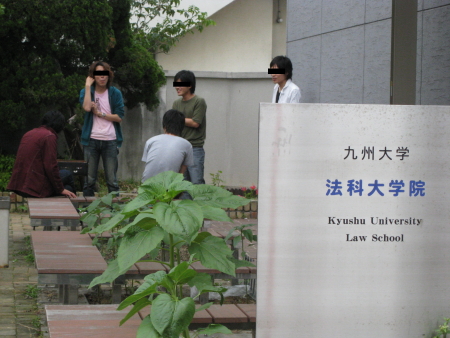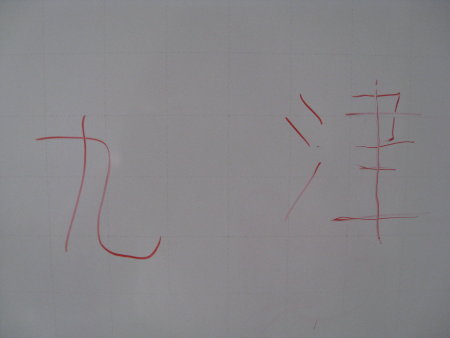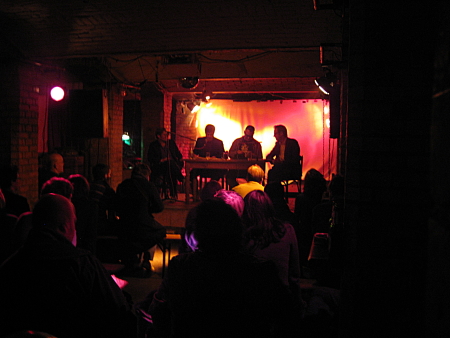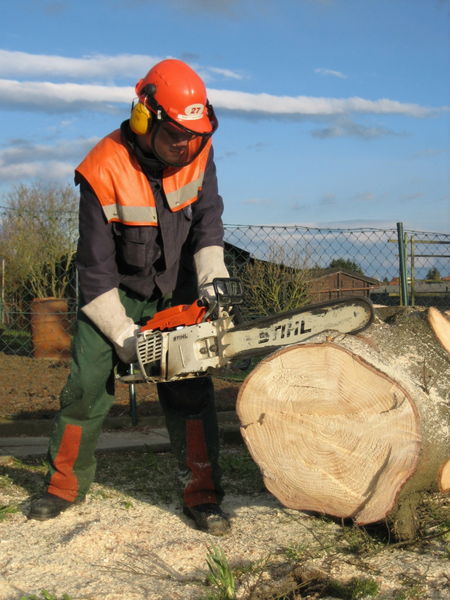focus and context, part IIa: A quantum computation game
Saturday, October 4th, 2008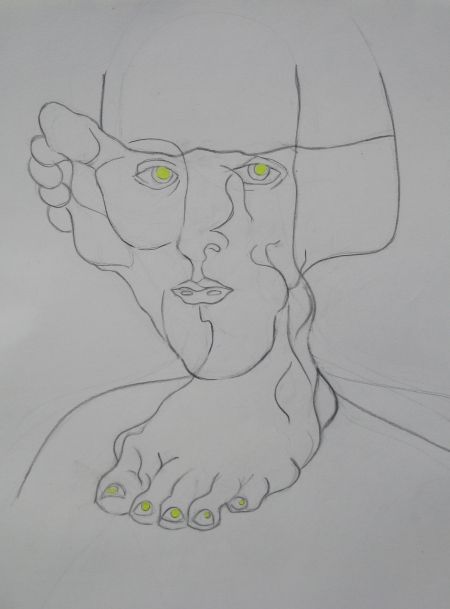
As already mentioned in the last post I am going to supervise the exercises of a quantum computing class. Quantum computation was already a couple of times mentioned on this blog (like here), but I never really explained it to our art and design readership.
This blogpost belongs to series of posts related to the issue of focus and context.
So how can one describe quantum computation within a few words? Michael Nielsen, who actually wrote a whole book with Isaac Chuang about quantum computing (and who seems to be fed up with it?), tried this already on his blog.
I would like to try the same however differently with maybe fewer words (?), by using an analogy. So hopefully my post is kind of supplementary to Michael Nielsens.
In a natural language the information is conveyed in a way which may be ambiguous, i.e. words may have many meanings and thus the interpretation of their meaning depends on a given context. One can see this e.g. in the ambiguity of translations.
An example:
Look at the in the above art work mentioned german word “wegetreten”. “wegetreten” could be interpreted as “wege treten” (weg=path, treten=step), so the translation would be “pathmaking” or it could be interpeted as the word “wegetreten” read as: “weg getreten” (weg=away, getreten=stepped) meaning “pushed away” or -as a second meaning “stepped aside” or it could be read as “weh getreten” (weh=pain) (with a slight orthographic deformation) and thus would mean “to have injured”. So if a CEO gives a speech and would say the sentence: “Mit unserem neuen Ansatz werden wir Wege treten, die uns in neue Dimensionen führen” (with our new ansatz we will produce plathways which will lead us into new dimenions) then due to the addition: “which will lead us into new dimensions” it is rather clear what he/she meant – it’s quite a standard CEO sentence.
However without the addition the meaning of that sentence would depend on the exact pronounciation (i.e. the “e” in “weg” would be spoken slightly shorter in “weg-getreten” than in wege-treten, which sounds the same as weh-getreten). If you cant perceive the precise pronouncation like because this CEO is always mumbling then “mit unserem neuen Ansatz werden wir Wege treten” could also mean: “with our new ansatz we will be pushed away”, I.e. it would have rather the opposite meaning of “with our new ansatz we will be producing new pathways”. One could probably recover the correct meaning of the sentence if one would know the rest of the speech, or if one would know to whom this sentence was adressed, i.e. if one would know the given context.
(There is a bit about Homonyms in this randform post. In this post also metaphors were mentioned. However including metaphors would make things even more complicated so lets leave them out for a moment).
So conveying the information “wegetreten” (like in a SMS and allowing for a slight orthographic freedom) means to convey at least the above four meanings of “wegetreten” – all at the same time. And if you send this information like in a SMS then the interpretation will depend on what the receiver of the information knows about you and his/hers interpretation will depend on that given context (a bit on the different approaches towards context sensitvity was mentioned in this randform post).
Other forms of context may be that the interpretation may depend on the emotional and/or psychological state of the receiver a.s.o. (The interpretation of a code (which is here in our above example a word), or in other words the choice of an associated meaning was already discussed a bit e.g. in this randform post. The difficulty of choosing codes were indicated here and here or here)
A “state” in quantum mechanics is something like a “word”, i.e. you send some information, but its actual information, that is its meaning – may be blurred. I.e. instead of having only one definite meaning or none at all (“word switched on or off”) the meaning could be ambiguous.
Lets simplify a bit and recall briefly what’s in a normal computer: A computer program can be seen as a high level “translation” of a table of “yes'” and “no’s” or “on and offs”. These tables of “yes” and “no’s” provide rules of how to modify “switches” (electronic components) which are connected so that they form “circuits”. These circuits in the turn modify data (which is also given in terms of “yes'” and no’s”). Sometimes the programm is “hardwired” (like burned into a chip) and thus forms a kind of unit with the electric circuits. In particular a “cascade of switches” can be seen as a programm.
So the information in a normal computer is encoded in terms of bits, i.e. giant tables of the two possibilities “yes” and/or “no”. One calls this often “binary” (logic) which comes from the greek word “bi=two”. In a quantum computer this is different, i.e. the information is “blurred”. This means that the information is usually not a definite “yes” or “no”. So it is a bit like in our above analogy.
One can actually simulate a quantum computer with a normal computer by using the mathematical description of quantum mechanics, however in most cases you would need giant computers for the simulation of a relative small quantum computer.
But lets return to the analogy:
Choosing a “word”, i.e. choosing a bunch of certain possible meanings is in analogy to a “quantum mechanical preparation of a state”. A quantum mechanical “measurement” is in analogy to an “interpretation”. Since the context is influencing the probability of an interpretation one could see “context” in analogy to a set of “quantum gates” or “quantum circuits” which are the “circuits” of a quantum computer.
Quantum circuits are in in analogy to the usual electronic circuits you have e.g. on your ardunio board, i.e. they manipulate data. However the physical realization of quantum circuits is different from usual electronical circuits since quantum circuits make direct use of quantum mechanics and the usual electronic circuit boards make use of quantum mechanics only in a rather indirect way. In particular the encoding and processing of information in quantum circuits is different (this is what I tried a bit to explain above) from the one for electronic circuits, which use -as already pointed out- binary (or other like e.g. ternary) logics.
Due to this difference this in particular implies that if you remodel binary logical gates like in genetic design (like in synthetic biology e.g. with biobricks or within DNA computing) then the outcome will more resemble an ordinary computer (however with biological substituents and may be partly fuzzy logic) than it will resemble a quantum computer. Although there may be quantum logical effects also in biological composites, as e.g. indicated in this randform post.
Using the above analogies you could play being a quantum computer with your friends. I.e. by sending out ambiguous sentences and by waiting for their interpretation (which you somewhat see by their response). You could form chains (“circuits”), where you transmit the information, similar to the game “Stille Post” – just that you may also reformulate.
However it should be pointed out that the above is only a more or less weak analogy. There are major differences between such a game and real quantum computing. One important difference is that once a quantum mechanical measurement took place the original quantum state is usually considered to be distroyed. In our analogy this would mean that once an interpretation has been made no other interpretation would be possible any more.
In particular if you (I call you Alice) send your information to someone called Bob and someone intercepts your communication and would interpret it then Bob would know that someone intercepted your communication since he couldn’t interpret your message anymore properly. This feature is at the heart of “quantum encryption“. Another basic feature is the socalled “entanglement” which would mean that – looking again at the analogy – two words are entangled. I.e. if someone interpretes one word then the meaning of the other word would be instantanously determined. This feature is at the heart of the socalled quantum teleportation protocoll.
On the other hand if one assumes that there may be quantum mechanical effects taking place in our brain then this would shed a different light on such a game. Unfortunately it is also clear that a quantitative evaluation of such a game would be extremely difficult, if not impossible, since it is related to personal interpretation. Maybe one can find more thoughts on that issue in this new book by A. Connes, M. Heller, S. Majid, R. Penrose, J. Polkinghorne and A. Taylor (which I haven’t looked at yet) (book blog).
One should make some comments on the possible important applications of quantum computers.
One application is that they could be used for evaluating theoretical models of mesoscopic quantum systems, which could be incredible helpful for the design of new materials (like for solar cells or nano medication) (see also this research seminar)(if we generously assume that patent laws are abolished, because otherwise I see quite some conflicts ahead which will be due to patented genes, patented software algorithms, patented processes of nanofabrication etc. )
Another fact is that there are certain computer algorithms with which certain problems can be solved much faster than with ordinary computers. In particular the security systems of banks and military are relying on such algorithms. In other words having such a powerful new computer would mean that one could break more or less into all current security codes in the world.
And that is why i consider it to be highly problematic if private companies are pursuing research in such a security relevant branch. And it would be especially brisant if these companies would be known for pursuing rather restrictive politics with regard to openness, intellectual property rights etc.
But that is also why quantum computing is a rather hot topic and thus a lot of students want to learn it and even do the exercises..:).
In my mathematical work I mainly touched upon a part of quantum computation which is called topological quantum computation. The main (rather loose) connections are dating back to my Ph.D. thesis (from 1996…) which I may put online, if I should ever find the time to do so. I may eventually also write up some stuff, which is sofar still somewhat buried in my mind.
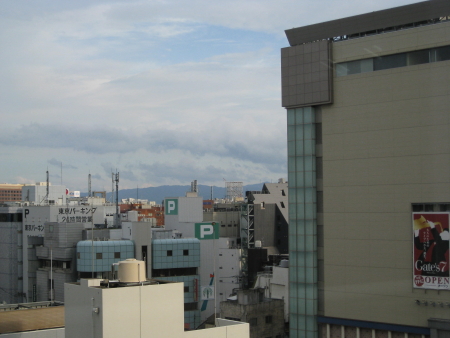


 ”Immer wieder la
”Immer wieder la 
